- 01422 292115
- info@seffirstaidassistance.co.uk
- Mon - Fri: 9:00 - 17:30

Blended Paediatric First Aid – Level 3

This 12-hour course has been developed for those who are working with children and infants. It will be of particular interest to teachers, child minders, nursery assistants, playgroup personnel and anyone else who has a responsibility for the welfare of children and infants. The purpose of the qualification is for the learner to attain the knowledge and practical competence required to deal with a range of paediatric first aid situations.
This qualification is recognised by Ofsted and fulfils the requirements for first aid training detailed in the Department for Education’s Early Years Foundation Stage framework.
The qualification is assessed both through practical demonstration and written assessment, including a multiple-choice question paper. The qualification is valid for 3 years from the date of achievement. It is recommended that the learner attends annual refresher training. The learner will need to complete the full course again to requalify for a further 3 years.
This option allows learners to complete one module online before attending the 6-hour practical session. All of the online training must be completed before the face-to-face session. This will be confirmed on arrival to the venue.
The online element does not need to be completed in one session. You have the flexibility to learn parts of the course at your own pace. If you are unsure or have a question, please email us at info@seffirstaidassistance.co.uk
The learner will:
SEF First Aid Assistance is the trading name of SEF LEGAL ASSISTANCE LTD (06519892).